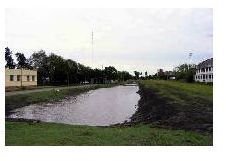Retention Ponds and Urban Lagoons - Rain Water Storage Units in Urban Planning
A Piece of History
Historically, urban water problems have been solved using an old theory that promotes having excess rain water flow as quickly as it can to the lowest basin point. In this way, water travels from neighborhood to neighborhood, causing the last one to be flooded.
This results in great expenditures in hydraulic constructions such as sewers, storm drains, curbs, etc. That means an obvious increase in costs, and as we know, cost is always one of the most important parameters when we think about any type of building construction.
This theory also promotes higher velocities to make the water flow quicker. Thus it is common to see, in urban or rural communities, concrete channels that are cheaper and easier to construct than landscaping (forming) and grass.
Yesterday, urbanization was not always considered in land use planning. This means that sometimes hydraulic buildings were constructed to serve a certain quantity of population, but then it was duplicated. Sometimes buildings had to be re-constructed, duplicated, or taken out of use, and this raised costs.
New Trends in Hydrology
In recent years a new trend in hydrology has emerged because of high urban development. This caused specialists to have to review theory and practice in this important area of civil engineering. Although physical laws haven’t changed, there is a new theory that considers the problems of rapidly increasing urbanization.
This new hydrology trend promotes water storage and water distribution through the basin, but how do we store rain water in an urban area?
Here is where land use planning is a must. To store water, we need to construct natural storage units. These lagoons, or rainwater or storm water retention ponds, must be located in green areas in the city, and they may be grass covered. We have to conduct excess rain water to the lagoons so that they can operate as a storage units.
Rain Water Storage Unit (Retention Pond)
The volume of water to be stored depends on the outlet pipe’s dimension. It’s important that pipe diameter be higher than 50cm to avoid obstructions. If the outlet pipe elevation is at floor elevation, the lagoon will work as a storage unit for the intended retention time after a storm. In case the outlet pipe bottom elevation is at a certain floor’s distance, water will always occupy the lagoon. In this case, an aeration system is generally used to avoid water ageing.
Another point to see to is inlet structures. Is very important that inlet pipe’s bottom height doesn’t allow backflow, so it may not be flooded upstream. This can be avoided using flap gates that prevents reverse flow through conduits.
Of course, the lagoons have to be designed to retain as much water as possible. In this way, downstream hydraulic dimensions will be considerably smaller than the same case without storage units.
.
